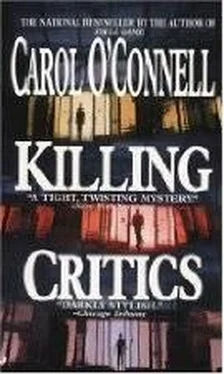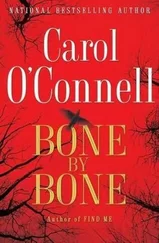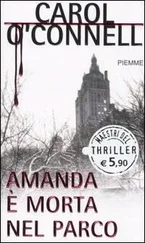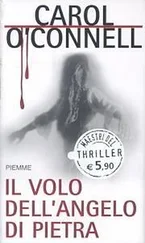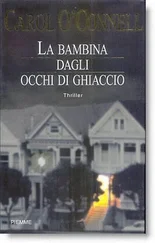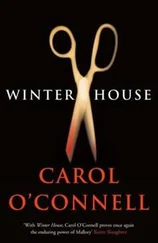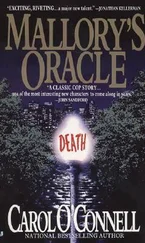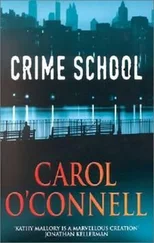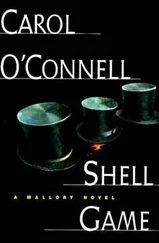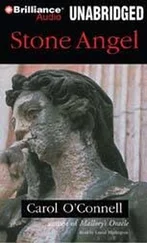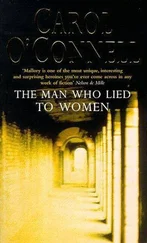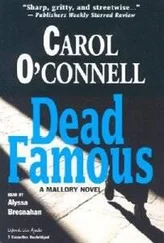Carol O’Connell - Killing Critics
Здесь есть возможность читать онлайн «Carol O’Connell - Killing Critics» весь текст электронной книги совершенно бесплатно (целиком полную версию без сокращений). В некоторых случаях можно слушать аудио, скачать через торрент в формате fb2 и присутствует краткое содержание. Жанр: Триллер, на английском языке. Описание произведения, (предисловие) а так же отзывы посетителей доступны на портале библиотеки ЛибКат.
- Название:Killing Critics
- Автор:
- Жанр:
- Год:неизвестен
- ISBN:нет данных
- Рейтинг книги:3 / 5. Голосов: 1
-
Избранное:Добавить в избранное
- Отзывы:
-
Ваша оценка:
- 60
- 1
- 2
- 3
- 4
- 5
Killing Critics: краткое содержание, описание и аннотация
Предлагаем к чтению аннотацию, описание, краткое содержание или предисловие (зависит от того, что написал сам автор книги «Killing Critics»). Если вы не нашли необходимую информацию о книге — напишите в комментариях, мы постараемся отыскать её.
Killing Critics — читать онлайн бесплатно полную книгу (весь текст) целиком
Ниже представлен текст книги, разбитый по страницам. Система сохранения места последней прочитанной страницы, позволяет с удобством читать онлайн бесплатно книгу «Killing Critics», без необходимости каждый раз заново искать на чём Вы остановились. Поставьте закладку, и сможете в любой момент перейти на страницу, на которой закончили чтение.
Интервал:
Закладка:
“Yes, a few times. Where shall we have lunch?”
“Did he do this in the old days, too?”
“The painting and waxing? Yes. Everyone does it. It’s standard.”
“Thanks, Charles. Now I’ll tell you why Oren Watt couldn’t have used this door to kill Dean Starr. When Koozeman did his little trick on the patrons, he was the one who positioned them. No one behind the door would know who was on the other side unless Koozeman was doing a planned setup. So an accomplice would have to position the victim, and then signal Watt to come through the door and stab the man. According to Watt’s confession, he works alone and never plans that far ahead.”
“All right. I’ll pay for lunch. Where shall we go?”
She was distracted. He followed her gaze to the entrance of the gallery, where J. L. Quinn was standing. How long had he been there?
“Mallory, isn’t this the second time he’s found you at Koozeman’s? It can’t be coincidence. He’s stalking you, isn’t he?”
“Or maybe he has some connection to Koozeman. We’ll do lunch tomorrow, Charles.”
“I was expecting the Gulag,” said Mallory, looking around at the appointments of the Tavern on the Green. She approved the cleaning job on the clear panes of glass looking out on Central Park, and she ignored the gang of tulips just beyond the window in a riot of color, each bloom openmouthed and screaming at the sun.
Quinn was reading the wine list. “Unless you have a preference, I’ll-”
“Frog’s Leap Cabernet Sauvignon, 1990,” said Mallory. “That year isn’t on the wine list. They only have a few bottles left. You may have to pay more to get the waiter to look for it.”
Quinn set down the menu. He seemed only vaguely disquieted by the fact that she might be accustomed to this place where one did not escape the table without a substantial outlay of cash. She sat back and watched him through half-closed eyes, wondering what other small cracks she might make in his composure.
When he had ordered the wine and the lunch, he folded his arms and leaned toward her. “Well, what shall we discuss? Art?”
“Marketing.”
“Same thing.”
“A lot of money flowed through Koozeman’s hands after Peter Ariel was killed. But most of it didn’t stay in his bank account or his investment portfolio.” And it never appeared on Koozeman’s tax returns, but Quinn didn’t need to know she’d found a back door to the IRS computers.
“Part of the money would have gone to investors. Koozeman was small-time in those days, so we can assume there was substantial backing to promote Peter Ariel. I imagine you’ve seen Koozeman’s old gallery in the East Village.”
She nodded, though she had never seen it except in cyberspace visions of paperwork, rent estimates, map locations and a floor plan. Now she thought she might make the trip to the East Village to check it out in the dimensions of real time and space.
A plate of appetizers appeared on the table with the unobtrusive flash of a waiter’s sleeve.
“There were no profits on Peter Ariel’s show,” she said. “Not on paper. But Ariel was dead less than three months, and suddenly Koozeman was paying ten times the rent for his new SoHo location. His investors paid for that, even when he had no buyers for the art?”
“The investors were the buyers.” The wine arrived and he paused for the rituals of reading the label and testing the contents. “It’s difficult to launch an artist in the primary market, particularly a sculptor like Ariel- no talent. Sometimes a dealer creates an artificial market to get the ball rolling.”
“The primary market-you mentioned that before.”
“That’s the initial sale. The secondary market is the resale of work. If you can generate a lot of hype, the demand for the art will exceed the supply. Then you go back to the buyers of the early work, and you broker resales for a share of the profit.”
Salad plates appeared with the finesse of fine service, and disappeared to be replaced with main courses. Between the leafy vegetables and the red meat, she learned the fine points of faking success in the art world-the kickbacks to grant committees for impressive lines on a resumé, the trade of advertising money for guaranteed reviews, and even the publicist’s fees.
“I can’t question Koozeman on the old case,” she said. “How do I find out who participated in the sales of Ariel’s work?”
“You don’t.” Quinn caught the waiter’s attention and mimed the word “coffee.” “Even if you could approach Koozeman, he wouldn’t give you any names. That list would be the most closely guarded thing he possessed.”
“Because he doesn’t want the police to bother his clientele?”
“Because some of the people on that list are probably not paying any capital gains taxes or sales tax.”
“He ran a tax scam?”
Conversation stopped as coffee cups were filled.
“I don’t know that he did anything illegal-I’m only speculating. You said there were no profits on paper from the last Ariel show. Let’s say most of Peter Ariel’s work was reported damaged on the night of the murder. In a tax audit, Koozeman would only have to produce the police report and letters from the initial buyers saying their money was returned to them because the work was damaged prior to delivery. But they might hold on to the work, and Koozeman might not actually return the money.”
“So he voids the check transactions by claiming refunds in cash. Then the cash goes into a safety deposit box?”
“ If it happened that way, the initial buyers would make a substantial tax-free profit on a cash resale. No capital gains tax for the initial buyer, no sales tax for the resale buyer, no income tax for Koozeman.”
“Could he use the same racket to sell what’s left of Dean Starr’s work?”
“I hardly think so. He actually did make a few sales the night Dean Starr was murdered. But the art is such a crock, the A list people wouldn’t touch it. The work was bought by ignorant gate crashers. For the second showing, he’ll probably sell directly to the amateurs.”
“So the primary market is the A list.”
“Right. That would be the money people. They’re not art lovers-only looking for investment ventures. Now if an artist dies with a lot of notoriety, that’s a windfall profit. The art is knowing when to unload the work before its value falls off.”
“So the A list unloads on the suckers from the B list.”
“And they may in turn sell to a C list, the ultimate morons who get stuck with worthless art. C list buyers are corporate collections and banks. They rarely notice they’ve been duped because the cost of the work is added to the asset value of the company. It’s a hidden loss, a worthless holding that won’t show up in an audit. And now you know all about art.”
“But I don’t know anything about Aubry’s mother. Why aren’t there any photographs of Sabra?” She had expected some reaction to that, but his composure never faltered.
“You can blame my father for that.” He leaned toward her. “My mother was every bit as beautiful as you are, Mallory. That’s why my father married her.”
Over another cup of coffee and dessert, she learned that Quinn’s father had not been married long before he discovered what hell it was to live with a woman obsessed by mirrors. One night, when Sabra was only twelve, her father said to her, “It’s a pity about your beauty. If only you had been born ugly or even ordinary, you might have developed an intellect.” He was drunk when he said that, but he meant it. He was afraid for his daughter.
Sabra had marched up the stairs and destroyed all the mirrors in her bedroom. Later, the Quinns began to notice the sabotage of family photographs all over the house. Eventually, she had destroyed every likeness of herself. She never wanted to see her own face again.
Читать дальшеИнтервал:
Закладка:
Похожие книги на «Killing Critics»
Представляем Вашему вниманию похожие книги на «Killing Critics» списком для выбора. Мы отобрали схожую по названию и смыслу литературу в надежде предоставить читателям больше вариантов отыскать новые, интересные, ещё непрочитанные произведения.
Обсуждение, отзывы о книге «Killing Critics» и просто собственные мнения читателей. Оставьте ваши комментарии, напишите, что Вы думаете о произведении, его смысле или главных героях. Укажите что конкретно понравилось, а что нет, и почему Вы так считаете.
